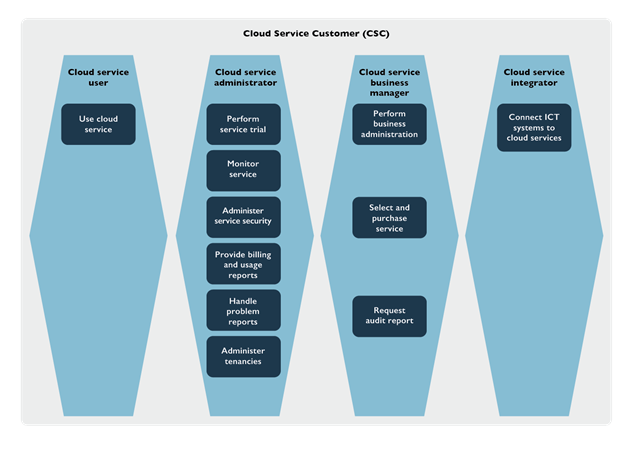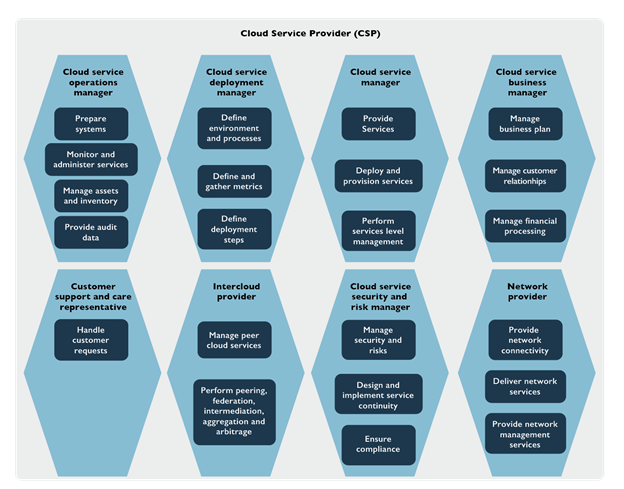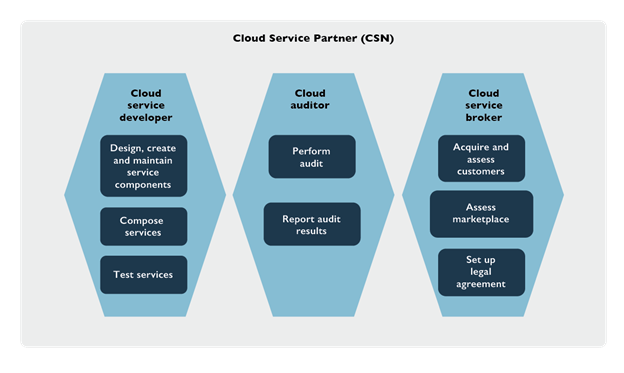With traditional computing and technology environments, there are several activities that are essential for creating, designing, implementing, testing, auditing, and maintaining the relevant assets. ISO/IEC 17789 links cloud computing activities to traditional technology environment activities by sub-role activities.

A cloud service customer’s activities include:
- Use cloud service activity: Use the services of a cloud service provider to accomplish critical security tasks
- Perform service trial activity: Use the services of a cloud service provider to ensure that the cloud service is fit for the cloud service customer’s business needs
- Monitor service activity: Monitor the delivered service quality with respect to service levels as defined in the service-level agreement (SLA) between cloud service customer and cloud service provider
- The administer service security activity: Ensure appropriate security for cloud service customer data, data backup, and recovery, administering security policies, defining encryption and integrity technologies, and defining the handling of any personally identifiable information (PII)
- Provide billing and usage reports activity: Prepare reports of the customer organization’s cloud services usage and associated reports of the billing/invoice data relating to that usage
- Handle problem reports activity: Perform customer-side handling of any reported problems associated with the usage of cloud services
- Administer tenancies activity: Administer the tenancies of the cloud service customer with the cloud service provider
- Perform business administration activity: Manage the business aspects of the use of cloud services, including accounting and financial management
- Select and purchase service activity: Examine the cloud service offerings to determine if the service meets cloud service customer business and technical requirements
- Request audit report activity: Request the report of an audit of the cloud service, typically conforming to a particular audit standard or scheme
- Connect ICT systems to cloud services activity: Integrate existing ICT systems and cloud services, connect existing ICT component(s) and applications with the target cloud service(s), and connect the customer monitoring and management systems with the cloud service provider’s monitoring and control of cloud services

A cloud service provider’s activities include:
- Prepare systems activity: Prepare the systems of the provider’s environment for new cloud service deployments
- Monitor and administer services activity: Monitor and administer services and their associated infrastructure, which includes user and system privileges
- Manage assets and inventory activity: Track all compute, storage, network, and software assets and the relationship between them, also “on-board” new assets and dispose of old assets
- Provide audit data activity: Collect and provide data relevant to an audit request, such as that relating to security controls or to service performance
- Defined environment and process activity: Define the required technical environment and operational processes used when a service is running
- Define and gather metrics activity: Define service-level metrics and management
- Define deployment steps activity: Define the steps for the deployment of services
- Provide services activity: Perform all steps required to deliver a cloud service to its cloud service customers
- Deploy and provision services activity: Get a service implementation running and make it available at a network end point accessible to the cloud service users, and make it able to handle service requests from users
- Perform service-level management activity: Manage compliance with SLA targets
- Manage business plan activity: Define a service offering, create a business plan that covers the offering of one or more cloud services to customers, track the sales and service usage against the plan, and prepare and adjust a business plan to provide cloud services
- Manage financial processing activity: Handle billing updates, generate billing information, and handle the receipt of payments from the cloud service customer
- Handle customer requests activity: Handle support requests, reports, and incidents from cloud service customers
- Manage peer cloud services activity: Manage the usage of cloud services of a peer cloud service provider
- Perform peering, federation, intermediation, aggregation and arbitrage activity: Use peer cloud service provider’s cloud services, which includes service federation, intermediation, aggregation, and arbitrage
- Manage security and risks activity: Manage security and risks associated with the development, delivery, use, and support of cloud services
- Design and implement service continuity activity: Consider potential modes of failure of a cloud service and the supporting infrastructure and put in place recovery processes that will enable the cloud service to be available within the terms of the SLA
- Ensure compliance activity: Implement regulatory and standards compliance
- Provide network connectivity activity: Set up requested network connections and related capabilities, including (amongst others) connections between the cloud service customer and the cloud service provider’s system and between one cloud service provider’s system and another cloud service provider’s system
- Deliver network services activity: Provide network-related services such as firewalls or load balancing
- Provide network management services activity: Manage the network infrastructure used to carry cloud services

A cloud service partner’s activities include:
- Design, create, and maintain service components activity: Design and create software components that are part of the implementation of a service, process problem reports, provide fixes, and provide enhancements to service implementations
- Compose services activity: Compose new cloud services by combining or modifying existing services
- Test services activity: Test the components and services created by the cloud service developer
- Perform audit activity: Request or obtain audit evidence, conduct any required tests on the system being audited, and obtain evidence programmatically
- Report audit results activity: Provide a documented report of the results of performing an audit
- Acquire and assess customer activity: Market and sell cloud services to the point where a cloud service customer agrees to a contract to use one or more services
- Assess marketplace activity: Assess the current cloud computing marketplace to identify and recommend cloud service(s) that allow the customer to meet desired goals
- Set up legal agreement activity: Establish the service agreement between the cloud service customer and the chosen cloud service provider(s)